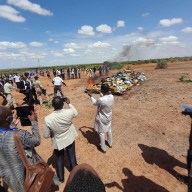FERNANDO DE NORONHA, Brazil – A Brazilian helicopter crew recovered the first wreckage from Air France Flight 447 on Thursday, pulling a cargo pallet from the sea. No sign of human remains has been spotted, and Air France has told families that the jetliner broke apart, killing all 228 people on board.
Two buoys – standard emergency equipment on planes – also were recovered from the Atlantic Ocean about 550 kilometres northeast of Brazil’s northern Fernando de Noronha islands by the helicopter crew, which was working off a Brazilian navy ship.
Air France’s CEO Pierre-Henri Gourgeon told family members at a private meeting that the Airbus A330 disintegrated, either in the air or when it slammed into the ocean and there were no survivors, according to Guillaume Denoix de Saint-Marc, a grief counsellor who was asked by Paris prosecutors to help counsel relatives.
Soldiers at Fernando de Noronha’s airport, where any recovered human remains would be taken, unloaded body bags and a refrigerator truck on Thursday from a military plane.
Flight 447 disappeared en route from Rio de Janeiro to Paris on Sunday night, the deadliest crash in Air France history and the world’s worst commercial air accident since 2001. A Canadian businessman was among those on board.
With the crucial black box voice and data recorders still missing, investigators were relying heavily on the plane’s automated messages to help reconstruct what happened as the jet flew through towering thunderstorms.
The messages detail a series of failures that end with its systems shutting down, suggesting the plane broke apart in the sky, according to an aviation industry official with knowledge of the investigation who spoke on condition of anonymity because he was not authorized to discuss the crash.
“What is clear is that there was no landing. There’s no chance the escape slides came out,” said Denoix de Saint-Marc, who heads a victims’ association for UTA Flight 772, which Libyan terrorists brought down with a suitcase bomb in 1989.
France’s accident investigation agency said only two findings have been established so far: One is that the series of automatic messages sent from Flight 447 gave conflicting signals about the plane’s speed; the other is that the flight path went through dangerously stormy weather.
The agency warned against any “hasty interpretation or speculation” after the French newspaper Le Monde reported, without naming sources, that the Air France plane was flying at the wrong speed.
Seas were calm Thursday with periodic rain as ships converged on three debris sites to recover wreckage, but “extreme cloudiness” prevented U.S. satellites from helping, said French military spokesman Christophe Prazuck.
“The clock is ticking on finding debris before they spread out and before they sink or disappear,” Prazuck said. “That’s the priority now, the next step will be to look for the black boxes.”
French planes and a U.S. navy P-3C Orion surveillance plane joined Brazil’s air force, whose pilots guided navy ships to debris areas across a search zone of 6,000 square kilometres, said Brazilian air force Gen. Ramon Borges Cardoso. He said collection of debris could begin Thursday. No bodies or body parts were seen.
Floating debris spotted so far includes a seven-metre chunk of plane, an airline seat, an oil slick and several large brown and yellow pieces that Cardoso said probably came from inside the plane.
A navy spokesman denied French media reports Thursday morning that ships had already started recovering debris. He spoke on condition of anonymity because of department policy.
Brazil’s Defence Minister Nelson Jobim said debris had spread more than 230 kilometres apart in currents roughly 640 kilometres northeast of the Fernando de Noronha islands off Brazil’s northern coast, where the ocean floor drops as low as 7,000 metres below sea level.
The Pourquoi Pas, a French sea research vessel carrying manned and unmanned submarines, is heading from the Azores and will be in the search zone by June 12, Prazuck said. The equipment includes the Nautile, a mini-sub used to explore the undersea wreckage of the Titanic, according to French marine institute Ifremer.
But the lead French investigator has questioned whether the recorders will ever be found in such deep and rugged underwater terrain.
While Brazil leads the search effort, France is in charge of the accident investigation, and has invited the U.S. National Transportation Safety Board to help. The U.S. team includes representatives from General Electric Aviation of Cincinnati, Ohio, which made the plane’s engines, and Honeywell International Inc. of Morristown, N.J., which made major components of the plane’s communication and navigation systems.
The mourning continues. More than 500 people packed the historic Candelaria church in the centre of Rio de Janeiro Thursday for a mass for the victims of crash. Some relatives quietly sobbed and others wore sunglasses to hide reddened eyes.
Carlos Eduardo Esteves, a 22-year-old law school student, came to remember Air France crew member Lucas Gagliano, a Brazilian who was on his way back home to France after attending his father’s funeral.
His eyes tearing up, Esteves said they had been friends for years.
“This is a form of saying goodbye to him. I feel so much loss, the nation has lost so much.”
The pilot sent a manual signal at 11 p.m. local time Sunday saying he was flying through an area of black, electrically charged cumulonimbus clouds that come with violent winds and lightning. The automated messages that followed suggest the plane broke apart in the sky, according to the aviation industry official.
At 11:10 p.m., a cascade of problems began: the autopilot had disengaged, a key computer system switched to alternative power, and controls needed to keep the plane stable had been damaged. An alarm sounded indicating the deterioration of flight systems.
Three minutes after that, systems for monitoring air speed, altitude and direction failed, and then controls over the main flight computer and wing spoilers failed as well.
The last automatic message, at 11:14 p.m., signalled loss of cabin pressure and complete electrical failure – catastrophic events in a plane that was likely already plunging toward the ocean.
Patrick Smith, a U.S. airline pilot and aviation analyst, said the failures could have begun with a loss of electrical power, possibly as the result of an extremely strong lightning bolt.
“What jumps out at me is the reported failure of both the primary and standby instruments,” Smith said. “From that point the plane basically becomes unflyable.”
“If they lost control and started spiralling down into a storm cell, the plane would begin disintegrating, the engines and wings would start coming off, the cabin would begin falling apart,” he said.
The pilot of a Spanish airliner flying nearby at the time reported seeing a bright flash of white light plunging to the ocean, said Angel del Rio, spokesman for the Spanish airline Air Comet.
“Suddenly, off in the distance, we observed a strong and bright flash of white light that took a downward and vertical trajectory and vanished in six seconds,” the pilot wrote in his report, del Rio told the AP.
The pilot of the Spanish plane, en route from Lima, Peru to Madrid, said he heard no emergency calls.
France’s defence minister and the Pentagon have said there were no signs that terrorism was involved, and Jobim, the Brazilian defence minister, said “that possibility hasn’t even been considered.”














